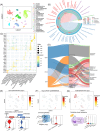Single-microbe RNA sequencing uncovers unexplored specialized metabolic functions of keystone species in the human gut
- PMID: 40469507
- PMCID: PMC12130570
- DOI: 10.1002/imt2.70035
Single-microbe RNA sequencing uncovers unexplored specialized metabolic functions of keystone species in the human gut
Abstract
The human body is inhabited by trillions of microorganisms that play a crucial role in health and diseases. Our understanding of the species and functional composition of the human gut microbiome is rapidly expanding, but it is still mainly based on taxonomic profiles or gene abundance measurements. As such, little is known about the species-function heterogeneity and dynamic activities in human microecosystem niches. By applying a novel gut-specific single-microbe ribonucleic acid (RNA) sequencing and analytical framework on three healthy donors with distinct enterotypes, we created a comprehensive transcriptional landscape of the human gut microbiome and dissected functional specialization in 38,922 single microbes across 198 species. We investigated the functional redundancy and complementarity involved in short-chain fatty acids related central carbon metabolism and studied the heterogeneity and covariation of single-microbe metabolic capacity. Comparing the human gut microbiome at different times throughout the day, we were able to map diurnal dynamic activities of the gut microbiome and discovered its association with sub-population functional heterogeneous. Remarkably, using single-microbe RNA sequencing, we systematically dissected the metabolic function heterogeneity of Megamonas funiformis, a keystone species in Asian populations. Together with in vitro and in vivo experimental validations, we proved M. funiformis can effectively improve mineral absorption through exogenous phytic acid degradation, which could potentially serve as a probiotic that reduces malnutrition caused by deficiency of mineral elements. Our results indicated that species-function heterogeneity widely exists and plays important roles in the human gut microbiome, and through single-microbe RNA sequencing, we have been able to capture the transcriptional activity variances and identify keystone species with specialized metabolic functions of possible biological and clinical importance.
Keywords: diurnal dynamic; gut microbiome; metabolism; single‐microbe RNA sequencing; species functional heterogeneity.
© 2025 The Author(s). iMeta published by John Wiley & Sons Australia, Ltd on behalf of iMeta Science.
Conflict of interest statement
Yongcheng Wang is a cofounder, and Jiong Liu is a cofounder and employee of M20 Genomics. The other authors declare no competing interests. The result that M. funiformis metabolize phytic acid to produce acetic acid and propionic acid has been filed for patent protection by Zhejiang University.
Figures







Similar articles
-
Species Deletions from Microbiome Consortia Reveal Key Metabolic Interactions between Gut Microbes.mSystems. 2019 Jul 16;4(4):e00185-19. doi: 10.1128/mSystems.00185-19. mSystems. 2019. PMID: 31311843 Free PMC article.
-
High-throughput single-microbe RNA sequencing reveals adaptive state heterogeneity and host-phage activity associations in human gut microbiome.Protein Cell. 2025 Mar 8;16(3):211-226. doi: 10.1093/procel/pwae027. Protein Cell. 2025. PMID: 38779805 Free PMC article.
-
Metage2Metabo, microbiota-scale metabolic complementarity for the identification of key species.Elife. 2020 Dec 29;9:e61968. doi: 10.7554/eLife.61968. Elife. 2020. PMID: 33372654 Free PMC article.
-
Exploring and evaluating microbiome resilience in the gut.FEMS Microbiol Ecol. 2025 Apr 14;101(5):fiaf046. doi: 10.1093/femsec/fiaf046. FEMS Microbiol Ecol. 2025. PMID: 40302016 Free PMC article. Review.
-
Next Generation Microbiome Research: Identification of Keystone Species in the Metabolic Regulation of Host-Gut Microbiota Interplay.Front Cell Dev Biol. 2021 Sep 1;9:719072. doi: 10.3389/fcell.2021.719072. eCollection 2021. Front Cell Dev Biol. 2021. PMID: 34540837 Free PMC article. Review.
References
LinkOut - more resources
Full Text Sources
Research Materials
